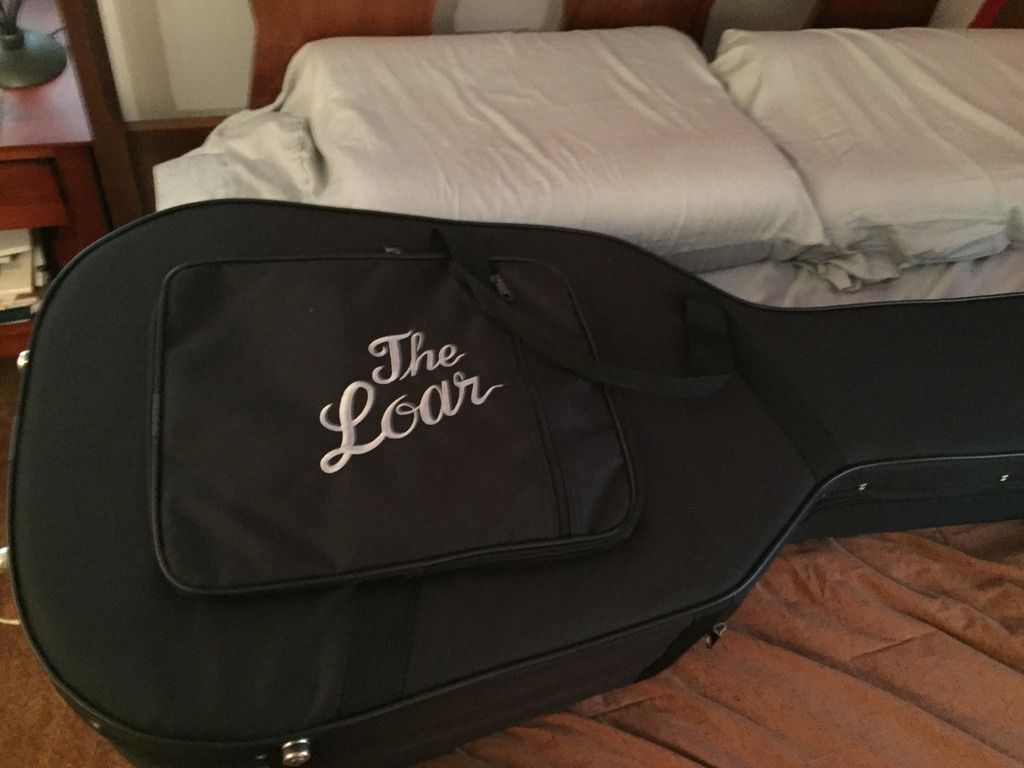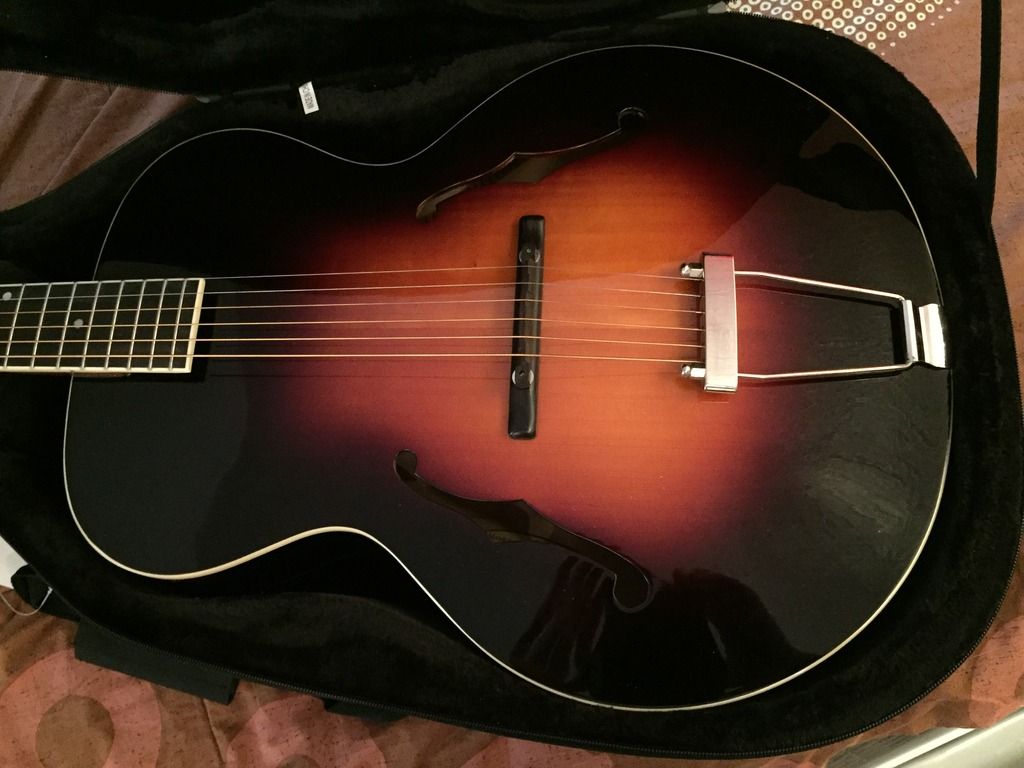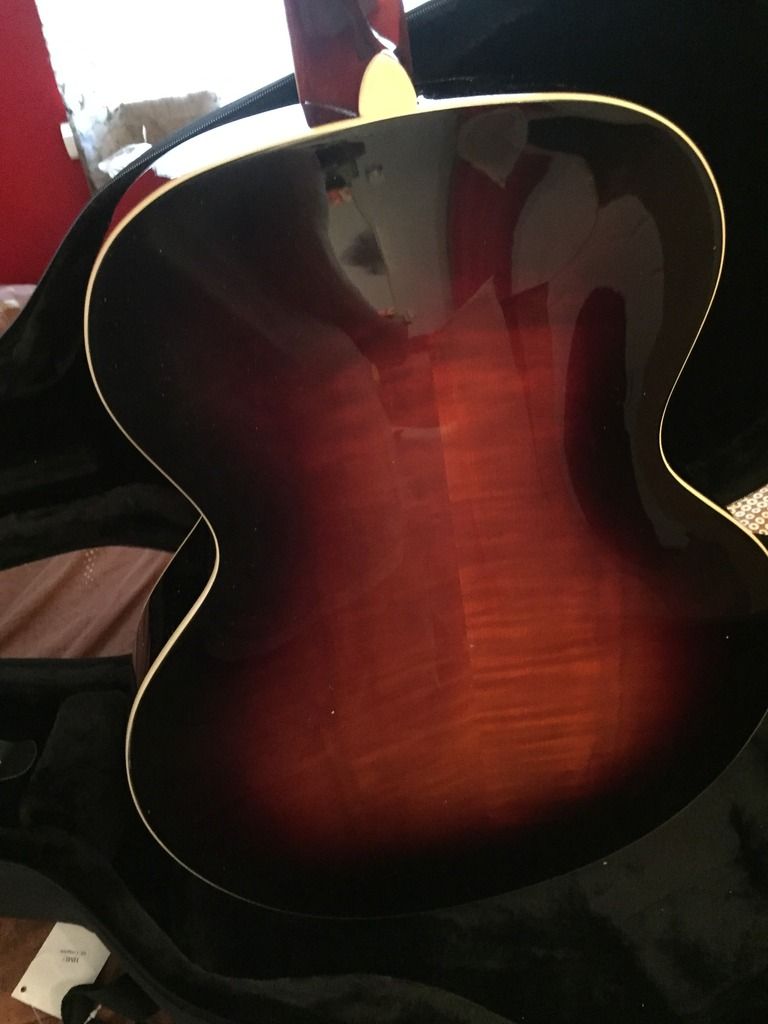
 |
|
#16
|
|||
|
|||
|
I didn't even realize there was an archtop forum. How would I get this reposted over there? I'll just make another post over there.
|
|
#17
|
|||
|
|||
|
Hi! I've been interested in adding some jazz styling to my repetoire, so on a whim just picked up a new all solid chinese made archtop, The Loar LH-600, to learn with the proper asthetic. Some questions:
1: what do I need to know for proper care of this beauty? 2: what strings? I've got some John Pearse Nuage (11) strings on the way, no idea if they are appropriate for this though. 3: resources for learning jazz standards? I've got a couple of Jody Fischer's books I'm going to work through for technique, but don't know where to go for material. I'm interested in hot club (manouche, whatever), western swing, stuff like that. Alright, pictures.   
|
|
#18
|
|||
|
|||
|
They are great sounding guitars, just a fact. Congrats
__________________
Dump The Bucket On It! |
|
#19
|
|||
|
|||
|
I have a Loar 700. I love it. The action was very high so I gave it a fairly radical sanding on the bridge, but after that, I really enjoy playing it and love the sound, for jazz, fingerpicking, flatpicking and "choppy" strummming. My only complaint is although it is spec'd at 1 3/4, its really more 1 11/16 which personally I find a little tight.
__________________
National Resophonic NRP 12 Fret Loar LH-700-VS Archtop Eastman E8-OM Herrmann Weissenborn Recording King RP-10 Recording King RG-35-SN Lapsteel Maton 425 12-string ESP 400 series telecaster Eastman T485 Deering Americana Banjo My Youtube |
|
#20
|
|||
|
|||
|
Why dark side?? This is a very good looking guitar. Congrats and happy playing!!!!
__________________
SCGC Custom OM Mars spruce/cocobolo |
|
#21
|
|||
|
|||
|
I'll start'ya off and let the rest chime in as things go along:

__________________
"Mistaking silence for weakness and contempt for fear is the final, fatal error of a fool" - Sicilian proverb (paraphrased) |
|
#22
|
|||
|
|||
|
Quote:
|
|
#23
|
|||
|
|||
|
Here's a few you might enjoy:
For "Gypsy Etude #3" the guitar is strung with light-gauge strings (probably ball-end manouche-style); compare the tone with "Nuages" and "Mala Femmena" - you'll see what I mean about the need for heavier gauges...
__________________
"Mistaking silence for weakness and contempt for fear is the final, fatal error of a fool" - Sicilian proverb (paraphrased) |
|
#24
|
|||
|
|||
|
So there is a fair amount of space under one end of the bridge, not under the strings, just on the end. How much of a concern is this?
|
|
#25
|
|||
|
|||
|
You always want the maximum amount of surface area contacting the top, no matter how good it sounds right now - get it properly fitted and you may be surprised how much tone you've been losing...
__________________
"Mistaking silence for weakness and contempt for fear is the final, fatal error of a fool" - Sicilian proverb (paraphrased) |
|
#26
|
|||
|
|||
|
I had one a couple of years ago. Very nice guitar with a real archtop tone. Great for jazz, there are a couple of YouTube examples/reviews. Mine spent too much time in the case (very nice lightweight) so I sold it on. Often wish I'd held on to it. I recently tried one of the new Epiphone Century archtops thinking I might buy one but they are not a patch on the tone from this Loar. One thing I noticed is, the finish is very brittle. It doesn't take kindly to the odd knock and it's very easy to end up with small dings.
|
|
#27
|
|||
|
|||
|
Speaking as one who builds and plays archtops, some guitars respond differently than other guitars. Try different strings, I find that lower tension strings make my archtops respond better and that heavy strings choke out the sound. A player's touch makes a big difference, people who play with a very heavy touch (as seems more common these days) need heavy strings and higher action to keep from over-driving the strings. I'm currently using a bluegrass set .012 - .056 and tuning down a step to D. The bass came really alive.
__________________
Brian Evans Around 15 archtops, electrics, resonators, a lap steel, a uke, a mandolin, some I made, some I bought, some kinda showed up and wouldn't leave. Tatamagouche Nova Scotia. |
|
#28
|
|||
|
|||
|
Awesome looking guitar, Darth Vader! Looking forward to a review.
|
|
#29
|
|||
|
|||
|
Since you're building your own archtops - a talent for which I have the utmost respect
 - you have the capacity to carve and fine-tune the plates/body cavity to your own desired response profile; unfortunately, that's not possible (except at great - and unnecessary - expense) with an off-the-shelf instrument. Given the fact that the OP is coming over from flattops (and that I've played a few of these same instruments since their release) your points about heavy touch and the subsequent need for heavier strings/higher action (among my own initial concerns, BTW) are well-taken; the LH-600 is as close as you're going to get (other than the upscale LH-700) to a Mother Maybelle/Eddie Lang L-5 in a new instrument, and IME the OP is going to need to set up his guitar in a more period-correct manner in order to bring out its best - since there's a current thread about "lame" tone, IMO that's a situation he doesn't need to deal with as a newcomer to the genre... - you have the capacity to carve and fine-tune the plates/body cavity to your own desired response profile; unfortunately, that's not possible (except at great - and unnecessary - expense) with an off-the-shelf instrument. Given the fact that the OP is coming over from flattops (and that I've played a few of these same instruments since their release) your points about heavy touch and the subsequent need for heavier strings/higher action (among my own initial concerns, BTW) are well-taken; the LH-600 is as close as you're going to get (other than the upscale LH-700) to a Mother Maybelle/Eddie Lang L-5 in a new instrument, and IME the OP is going to need to set up his guitar in a more period-correct manner in order to bring out its best - since there's a current thread about "lame" tone, IMO that's a situation he doesn't need to deal with as a newcomer to the genre...
__________________
"Mistaking silence for weakness and contempt for fear is the final, fatal error of a fool" - Sicilian proverb (paraphrased) Last edited by Steve DeRosa; 11-10-2016 at 05:21 PM. Reason: Typo |
|
#30
|
|||
|
|||
|
Steve has given you lots of good advice. I've owned a couple of Loar Archtops, so I'd second the suggestion to get it set up as well as possible - bridge seating, placement for intonation, and tailpiece clearance from the body as Loar neck angles tend to be very shallow.
As far as strings are concerned - I started off with "special" strings - nickels, monels etc., but now I use the same as on my dreads - D'addario - EJ17s (13-56). They sound fine, although monels and nickels might last longer before corroding , going off. Good luck!
__________________
Silly Moustache, Just an old Limey acoustic guitarist, Dobrolist, mandolier and singer. I'm here to try to help and advise and I offer one to one lessons/meetings/mentoring via Zoom! |